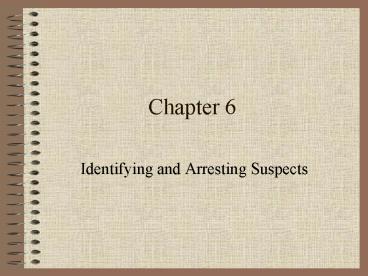Identifying and Arresting Suspects - PowerPoint PPT Presentation
1 / 19
Title: Identifying and Arresting Suspects
1
Chapter 6
- Identifying and Arresting Suspects
2
Identifying a Suspect at the Scene
- Identification by drivers license
- Drivers License Guide
3
Field Identification/Show-Up Identification
- Field Identification or show-up identification is
on-the-scene identification of a suspect by a
victim of or witness to a crime. Field
identification must be made within a short time
after the crime was committed. - U.S. v. Ash, Jr. (1973) established that a
suspect does not have the right to have counsel
present at a field identification.
4
Suspects are Developed by
- Information provided by the victims, witnesses
and other persons - Physical Evidence left at the crime scene
- Psychological profiling
- Information in police files
- Information in the files of other agencies
- Informants
5
Victim and Witness Information
- Ask very specific questions
- Use mug shots of possible suspects
- Use composite drawings and sketches
- Examining modus operandi information
6
Information in Police Files and Other Agencies
- Community Level
- County Level
- State Level
- Federal Level
- INTERPOL The International Criminal Police
Organization - Private Agencies
7
Identifying Suspects
- Photographic Identification A suspect does not
have the right to a lawyer if a photographic
lineup is used (U.S. v. Ash). - Lineup Identification Suspects may refuse to
participate in a lineup, but such refusals can be
used against them in court (Schmerber v.
California). Suspects have a 6th Amendment right
to have an attorney present during a lineup (U.S.
v. Wade).
8
Surveillance
- Surveillance (literally, to watch over) is the
covert, discreet observation of people or places. - The surveillant is the plainclothes investigator
who makes the observation. - The subject is who or what is being observed.
- Surveillance can be either stationary or moving.
- Tail, rough tail, open tail, loose tail, close
(tight) tail.
9
Surveillance Equipment
- Binoculars
- Telescopes
- Night-vision equipment
- Body wires
- Video systems
- Cameras
- Aerial Surveillance
- Visual/Video Surveillance
- Audio Surveillance
10
Undercover Assignments
- Obtain evidence for prosecution
- Obtain leads into criminal activities
- Check reliability or witnesses or informants
- Gain information about premises for future
- Check the security of a person in highly
sensitive position - Obtain evidence against subversive groups
11
Precautions for Undercover Agents
- Do not write notes the subject can read
- Carry no identification other than the cover ID
- Ensure that any communication with headquarters
is covert - Do not suggest, plan initiate or participate in
criminal activity (avoid entrapment)
12
Precautions in Conducting Raids
- Ensure that the raid is legal Search Warrant
- Plan carefully
- Assign adequate personnel and equipment
- Brief every member of the raiding party
- Be aware of surveillance devices at the site
13
Legal Arrests
- Arrest The taking of a person into custody in
the manner authorized by law for the purpose of
presenting that person before a magistrate to
answer for the commission of a crime.
14
Police Officers are authorized to make an Arrest
- For any crime committed in their presence.
- For a felony not committed in their presence if
they have probable cause to believe the person
committed the crime. In some states they can
arrest for a misdemeanor not committed in their
presence. - Under the authority of an arrest warrant.
15
Use of Force in making an Arrest
- Use only as much force as is necessary
- Reasonable force is the amount of force a prudent
person would use in similar circumstances - Exceptional force means more than ordinary force
16
Graham v. Conner
- Five Factors to evaluate excessive force
- Severity of the crime
- Suspect posed an immediate threat
- Circumstances were tense, uncertain
- Suspect attempting to evade arrest
- Suspect actively resisting arrest
17
Deadly Force
- Tennessee v. Garner (1985)
- The Court banned police from shooting to kill
fleeing felons unless an imminent danger to life
exists. A police officer may not seize an
unarmed, non-dangerous suspect by shooting him
dead.
18
Suicide by Police
- Suicide by police is a phenomenon I which someone
intentionally acts so threatening toward officers
as to force them to fire,accomplishing the
subjects ultimate goal of dying, albeit not by
their own hand.
19
(No Transcript)































